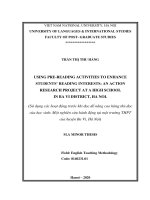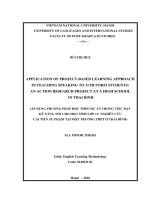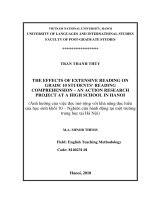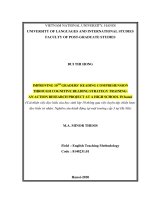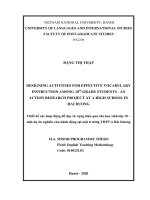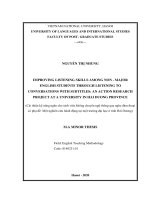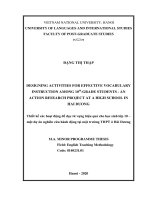Improving listening skills among non major english students through listening to conversations with subtitles an action research project at a university in hai duong province
Bạn đang xem bản rút gọn của tài liệu. Xem và tải ngay bản đầy đủ của tài liệu tại đây (850.6 KB, 74 trang )
VIETNAM NATIONAL UNIVERSITY, HANOI
UNIVERSITY OF LANGUAGES AND INTERNATIONAL STUDIES
FACULTY OF POST- GRADUATE STUDIES
---oOo---
NGUYỄN THỊ NHUNG
IMPROVING LISTENING SKILLS AMONG NON - MAJOR
ENGLISH STUDENTS THROUGH LISTENING TO
CONVERSATIONS WITH SUBTITLES: AN ACTION RESEARCH
PROJECT AT A UNIVERSITY IN HAI DUONG PROVINCE
(Cải thiện kỹ năng nghe cho sinh viên không chuyên ngữ thông qua nghe đàm thoại
có phụ đề: Một nghiên cứu hành động tại một trường đại học ở tỉnh Hải Dương)
M.A MINOR THESIS
Field: English Teaching Methodology
Code: 8140231.01
Hanoi - 2020
VIETNAM NATIONAL UNIVERSITY, HANOI
UNIVERSITY OF LANGUAGES AND INTERNATIONAL STUDIES
FACULTY OF POST- GRADUATE STUDIES
---oOo---
NGUYỄN THỊ NHUNG
IMPROVING LISTENING SKILLS AMONG NON - MAJOR
ENGLISH STUDENTS THROUGH LISTENING TO
CONVERSATIONS WITH SUBTITLES: AN ACTION RESEARCH
PROJECT AT A UNIVERSITY IN HAI DUONG PROVINCE
(Cải thiện kỹ năng nghe cho sinh viên không chuyên ngữ thông qua nghe đàm thoại
có phụ đề: Một nghiên cứu hành động tại một trường đại học ở tỉnh Hải Dương)
M.A MINOR THESIS
Field: English Teaching Methodology
Code: 8140231.01
Supervisor: Huỳnh Anh Tuấn, Ph. D
Hanoi - 2020
DECLARATION
I certify that this minor thesis entitled “Improving listening skills
among non - major English students through listening to conversations
with subtitles: An action research project at a university in Hai Duong
province” is the study of my own research and the substance of this research
has not been submitted for a degree to any other university or institution.
Hanoi, 2020
Student’s signature
Nguyễn Thị Nhung
i
ACKNOWLEDGEMENTS
First and foremost, I would like to express my deepest gratitude to Dr.
Huynh Anh Tuan, my supervisor, for his assistance, encouragement as well as
the guidance he gave while I was doing this research.
Second, I would like to express my special thanks to all lectures of the
Post Graduate Faculty of University of Language and International Studies,
Vietnam National University, Hanoi for their scholarly knowledge that helped
to enhance my interest for English Methodology and my teaching career.
I also wish to show my appreciation to my non - major students of the
class K10 for their whole - hearted participation in the study.
Last but not least, I owe my sincere thanks to my parents, my young
sister and my colleagues, my friends who have always inspired and
encouraged me to complete this study.
ii
ABSTRACT
This study focuses on improving students’ listening skills through
listening to conversations with subtitles. Besides, it investigated the students’
attitudes towards this technique. The study adopted action research approach
and was conducted by survey questionnaires, interviews and test among the
participation of 32 non - major English students at a university in Hai Duong.
Based on the data collection and analysis, the findings revealed the
improvement of the students’ listening comprehension and their overall
positive attitudes towards the technique.
iii
TABLE OF CONTENTS
DECLARATION .............................................................................................. i
ACKNOWLEDGEMENTS............................................................................ ii
ABSTRACT .................................................................................................... iii
LISTS OF FIGURES & TABLES ................................................................ vi
CHAPTER I INTRODUCTION.................................................................... 1
1.1. Rationale..................................................................................................... 1
1.2. Aims and objectives of the study ............................................................... 3
1.3. Research questions ..................................................................................... 3
1.4. Scope of the study ...................................................................................... 3
1.5. Method of the study ................................................................................... 3
1.6. Significance of the study ............................................................................ 4
1.7. Structure of the thesis ................................................................................. 4
CHAPTER II LITERATURE REVIEW ...................................................... 6
2.1. Overview of listening skill ......................................................................... 6
2.1.1. Definition of listening skill ..................................................................... 6
2.1.2. The importance of listening skill ............................................................ 7
2.2. Overview of listening to conversations with subtitles .............................. 9
2.2.1. Definition of subtitles .............................................................................. 9
2.2.2.Types of subtitles .................................................................................. 10
2.2.3. Advantages and disadvantages of listening to conversations with
subtitles............................................................................................................ 11
2.2.4. The effects of listening to conversations with subtitles ........................ 13
2.2.5. Previous studies ..................................................................................... 14
CHAPTER III METHODOLOGY ............................................................. 16
3.1. Research approach: Action research ........................................................ 16
3.2. Research setting ....................................................................................... 18
iv
3.3. Participants ............................................................................................... 18
3.4. Data collection instruments ...................................................................... 18
3.4.1. Comprehension Test.............................................................................. 19
3.4.2. Questionnaires and Interviews .............................................................. 19
3.5. Data collection procedures ....................................................................... 20
3.6. Data analytical framework ....................................................................... 24
CHAPTER IV FINDINGS AND DISCUSSION ........................................ 25
4.1. Findings .................................................................................................... 25
4.1.1. The improvement of the students’ listening skills after the intervention .... 25
4.1.2. The students’ attitudes towards listening to conversations with subtitles ... 28
4.2. Discussion ................................................................................................ 33
4.3. Summary .................................................................................................. 35
CHAPTER V CONCLUSION ..................................................................... 36
5.1. Summary of the study .............................................................................. 36
5.2. Recommendations for listening to conversations with subtitles effectively .. 36
5.2.1. Some recommendations for teachers in teaching listening skills ......... 37
5.2.2. Some recommendations for students in learning listening skills .......... 38
5.3. Limitations of the study and suggestions for further study ..................... 41
REFERENCES .............................................................................................. 43
APPENDICES .................................................................................................. I
APPENDIX 1 PRE - TEST ................................................................................ I
APPENDIX 2 POST - TEST .......................................................................... IV
APPENDIX 3 POST - INTERVENTION QUESTIONNAIRES.................. VII
APPENDIX 4 CÂU HỎI KHẢO SÁT SAU KHI CAN THIỆP ...................... X
APPENDIX 5 POST - INTERVENTION INTERVIEWS........................... XIII
APPENDIX 6 SAMPLE LESSON PLAN..................................................... XV
v
LISTS OF FIGURES & TABLES
Figures
Figure 1. Steps of action research process ...................................................... 17
Figure 2. Data analytical framework............................................................... 24
Figure 3. The comparison result between the pre - test and the post - test ..... 27
Tables
Table 1. The procedure of the syllabus ........................................................... 21
Table 2. The score of pre - test and post - test of 32 students......................... 25
Table 3. Descriptive paired samples statistics for 32 non - major English
students on the Pre - Test & Post - Test .......................................................... 26
Table 4. Paired Samples Correlations ............................................................. 26
Table 5. The result of paired sample test ........................................................ 26
Table 6. The students’ attitudes towards listening to conversations with
subtitles after the intervention ......................................................................... 29
vi
CHAPTER I
INTRODUCTION
This chapter presents a general overview on the rationale; aims and
objectives; research questions; scope and method, significance of the study;
the structure of the thesis are also provided.
1.1. Rationale
Communication is always important in every day life. People got to
communicate by using language to interact with people and to express their
feelings or share ideas and thoughts. Everybody acquires our native language
through our social environment since we were children. However, we are
demanded to be able to communicate well not only in our language but also
by using an international language like English. English is used
internationally in business, political, cultural relations, and education as well.
Thanks to the widespread use of English, different countries compared to
every other to figure out problems and strive for a prosperous community.
Vietnamese learners find the significance of English, they have made efforts
to be good at English. The study of English becomes easier because of
communication with foreigners and using modern equipment. Besides, people
still get difficulties in learning English. Out of all four language skills
mentioned, listening is the basic skills needed for communication. Listening is
the ability to spot and understand what others are saying. It is said that
listening is the most difficult skill for students learning English in practice,
especially the non - major English students because they do not have a chance
to practice frequently in upper schools. Listening is a child’s first
1
communication activity, it is essential for learning about and participating in
life. According to Wilt M.E (1950), it was found that 45 % of communication
was listening, 30 % speaking, 16 % reading, and 9% writing. Listening may
be a skill that has got to be at the forefront of English learning skills.
Listening is not only crucial for the learners to understand how to study the
language but also it is an important life skill. Without listening skills, there
can be no language learning, and hence no communication, listening skill is
the most important interaction human beings are involved in. However, the
listening competence of non - major English students are, as a matter of fact,
not qualified enough. At high schools they did not have chances to practice
English listening frequently, they mainly concentrate on grammar - related
skills. They are trained to do grammar and reading exercises. But, at
universities and colleges, all language skills are focused, especially speaking
and listening. It is a common problem that most of the students are unable to
communicate confidently.
Because of awareness of the importance of listening skills, students are
always trying to find ways to improve learning skills. One of the most useful
methods is listening to English conversations with subtitles. This method
offers a lot of advantages to the development of students’ abilities. To help
students have a better understanding of this technique, the researcher
conducted a study: “Improving listening skills among non - major English
students through listening to conversations with subtitles: An action
research project at a university in Hai Duong province”. It is hoped that this
study will encourage students to learn English, especially listening skills.
2
1.2. Aims and objectives of the study
The ultimate aims of the study is to see how listening to conversations
with subtitles improve. Especially, this study has two objectives:
1. To find out the extent to which listening to English conversations
with subtitles improved the non - major English students’ listening skills.
2. To investigate the students’ attitudes towards listening to
conversations with subtitles.
1.3. Research questions
The researcher plans to answer the following questions:
1. To what extent does listening to conversations with subtitles improve
the students’ listening skills?
2. What are the students’ attitudes towards listening to conversations
with subtitles?
1.4. Scope of the study
This study was conducted to improve the students’ listening skills such
as hearing and getting main information, catching key words, remembering
key words in short - term memory and understanding phrases or sentences to
communicate clearly and slowly, discriminating among the sound of English,
recognizing stress and intonation patterns through listening to conversations
with subtitles. The linguistic and technic subtitles were used in listening
process.
1.5. Method of the study
To achieve the aims of the study, action research was applied. There
were eight lesson plans, which were designed and taught at a class with 32
non - major English students at a university in Hai Duong province so that the
3
researcher find out how to improve listening skills through listening to
conversations with subtitles by a quantitative method. The students did the pre
- test and post - test. Besides, the researcher investigated the students’
attitudes towards listening to conversations with subtitles. The teacher
designed a survey to collect data and interviewed students, related to listening
to conversations with subtitles. Other research instruments were also designed
and applied. A pre-test and a post - test were given to evaluate improving
listening skills for students after the intervention. The students’ scores in the
post - test were compared with the students’ score in the pre-test to the effect
of listening to English conversations with subtitles on improving learning
listening skills. Finally, the data were collected and analyzed quantitatively
and qualitatively to obtain the results.
1.6. Significance of the study
As mentioned above, the study is carried out to help students to know
how to learn listening skills better and deeply understand the effect of
listening to English conversations with subtitles on improving learning
listening skills.
1.7. Structure of the thesis
The thesis consists of mainly five chapters:
- Chapter I is introduction, presents the rationale, the aims and
objectives, the scope, the methods, the significance and the structure of the
thesis;
- Chapter II is the literature review with the main key theories “the
definition of listening, the importance of listening, definition of subtitles,
4
types of subtitles, advantages and disadvantages of listening to conversations
with subtitles and the effects, previous studies.
- Chapter III is the methodology. This chapter introduces research
approach - action research, research setting, participants, data collection
instrument and data collection procedures;
- Chapter IV is the study, findings and discussion;
- Chapter V is the conclusion that provides summary of the study,
recommendations for listening to conversations with subtitles effectively and
limitation of the study.
5
CHAPTER II
LITERATURE REVIEW
In this chapter, the researcher presents the relevant literature on
listening skill and conversations with subtitles. The first part deals with
listening skill, which is followed by the definitions and the importance. The
last section of this chapter discusses conversations with subtitles including
definitions of subtitles, types of subtitles, advantages and disadvantages of
listening to conversations with subtitles, effects of listening to conversations
with subtitles on improving learning listening skills and previous studies.
2.1. Overview of listening skill
2.1.1. Definition of listening skill
Listening is the skill that students will be judged most in real life
situations. It is an important part of everyday interaction.
Listening, as Howatt and Dakin (1974) define, is the ability to spot and
understand what others are saying. This involves understanding a speaker’s
accent and pronunciation, his grammar and his vocabulary and grasping his
meaning. The listener is capable of doing these four things simultaneously.
Thomlison’s (1984) definition of listening includes “active listening” which
matches beyond comprehending as understanding the message content, to
comprehension as an act of empathetic understanding of the speaker.
In the view of Ronald and Roskelly (1985), listening as a lively
process. It requires an equivalent skills of prediction, hypothesizing,
checking, revising, and generalizing that writing and reading demand; and
6
these authors present specific exercises to make student active listeners who
are aware of the “inner voice” one hears when writing.
As defined by Oxford (1993: 206), “Listening is a complex, problem
solving skill” and it is “more than just perception of the sounds. Listening
includes comprehension of meaning bearing words, phrases, clauses,
sentences and connected discourse”.
A noticeable definition given by Rost (1990) is that “Listening is one
of the fundamental language abilities that allow users of language getting not
only information but also instruction”.
According
to
Rivers
and
Temperley
(1978:
63),
listening
comprehension is “not a passive but an active process of constructing a
message from a stream of sounds with what one knows of the phonological
semantic and syntactic potentialities of the language”.
Another definition of listening was offered by Saricoban (1999):
“Listening is more than merely hearing words. It is a process in which
students receive, construct meaning from and respond to spoken or nonverbal
messages”.
In general, listening is a dynamic and conscious mental activity in
which learners construct understanding by using clues from the contextual
information or the previous cognition.
2.1.2. The importance of listening skill
Listening plays an important role in communication in people’s daily
lives. As Guo and Wills (2006: 3) state “it is the medium through which people
gain a large proportion of their education, their information, their understanding
of the world and human affairs, their ideals, sense of values”.
7
According to Mendelson (1994: 9) “of the total time spent on
communicating, listening takes up 40 - 50 %; speaking 25 - 30 %; reading 1116 %; and writing about 9 %”.
Emphasizing the importance of listening in language learning, Peterson
(2001: 87) states that “no other type of language input is easy to process as
spoken language, received through listening … through listening, learners can
build an awareness of the interworkings of language systems at various levels
and thus establish a base for more fluent productive skills”. Listening has a
crucial role not only in lifestyle but also in classroom settings.
Anderson and Lynch (2003: 3) state that “we only become conscious of
what remarkable feats of listening we achieve once we are in an unfamiliar
listening environment, like taking notes of a language in which we have
limited proficiency”. Most people think that having the ability to write down
and speak during a second language means they know the language; however,
if they do not have the efficient listening skills, it is not possible to
communicate effectively. That is, listening is the basic skill in language
learning and over 50% of the time that students spend functioning in a foreign
language will be devoted to listening (Nunan, 1998). Rost (1994) explains the
importance of listening in language classroom as follows:
1. Listening is significant within the language classroom because it
provides input for the learner. Without understanding input at the proper
level, any learning simply cannot begin.
2. Speech provides a way of interaction for the learner. Because
learners must interact to achieve understanding. Access to speakers of the
language is essential. Moreover, learners’ failure to know the language they
hear is an impetus, not an obstacle, to interaction and learning.
8
3. Authentic speech presents a challenge for the learner to know
language as native speakers actually use it.
4. Listening exercises provide teachers with a means for drawing
learners’ attention to new forms (vocabulary, grammar, new interaction
patterns) in the language (p. 141-142).
To summarize, listening has a crucial role both in lifestyle and in
academic contexts because it is crucial for people to sustain effective
communication. Emphasizing the importance of listening, Anderson and
Lynch (2003) state that listening skills also are important as speaking skills
because people cannot communicate face-to-face unless both types of skills
are developed together. Listening skills are also important for learning
purposes since through listening students receive information and gain
insights (Wallace, Stariha & Walberg, 2004).
2.2. Overview of listening to conversations with subtitles
2.2.1. Definition of subtitles
According to Sydorenko (2010), on- screen text can be shown in
various forms: subtitles (L1 text, L2 sound), reversed subtitles (L1 sound, L2
text), or captions (sound is in the same language as the text). Jacob B.
Scheffer (2014) states that the terms “captions” and “subtitles” are used
somewhat interchangeably. “Captioning”, initially invented as a way to help
the impaired hearing for television, is the use of an equivalent language text
on a video screen concurrent with the audio of the spoken text (Price, 1983).
“Subtitles”, as defined by Livingstone (2013), are usually within the viewer’s
L1 or other language text on screen concurrent with the L2 spoken audio, and
therefore the text could also be paraphrased so that the text on the screen
matches the scene. However, according to Danna (2004), captions are “called
9
teletext subtitles in Europe, with subtitles in the same language as the sound
track” (p.68).
Therefore, in this study, I just focus on subtitles as captions with L2
sound and L2 text (both in English). In other words, the term “subtitles” and
“captions” are used alternatively indicating the verbatim transcription of the
original language (English) of the videos.
2.2.2. Types of subtitles
Subtitles can be classified into various types, the majority of subtitling
studies focus on two characteristics: linguistic and technical. Therefore,
according to Gottlieb (1997: 71-72), subtitles are categorized into linguistic
and technical perspective.
Linguistically, there are two different types of subtitles. First, that is
intralingual subtitling, within a similar language. Both the subtitling of local
programmes, subtitles within the same language for the deaf and hard of
hearing and subtitles for people learning languages fall in this group. Second,
interlingual subtitling, between two languages.
Technically, there are open and closed subtitles. Open subtitles are
associated with the initial film or the television version. As to Gottlieb, all
film subtitling belongs within this category, as “Even today, electronic
subtitling is proscribed to television and video” (Op. cit.: 72). Closed
subtitles, which can be voluntarily added; both to teletext and satellite
channels, offer various subtitled versions to different frequencies.
Ivarsson (1992: 35), distinguishes multilingual and teletext subtitling.
The multilingual subtitling is for cinema and television, in which the
translation appears in more than one language, as is often done in bilingual
states. The teletext subtitling is shown on television for the hard of hearing. It
10
is reduced subtitling and similar to teletext in the subtitling of news or live
events such as sports broadcasts; the translation of opera, theatrical works,
conferences. Ivarsson said that “the titles displayed on a special screen” (Op.
cit.: 35). It seems that Ivarsson has focused more on the technical than the
linguistic aspects.
Luyken (1991: 40), too, distinguishes between traditional subtitling and
simultaneous subtitling. The traditional subtitling has three subgroups of
subtitling in complete, reduced or bilingual sentences.
Linde (1999: 2) basically distinguishes between interlingual subtitling
and intralingual subtitling for the hard of hearing and television, given that
intralingual subtitling is, according to the author, non-existent in cinema.
Díaz Cintas (2001: 24) also offers a classification of subtitles,
distinguishing basically between traditional subtitling and simultaneous
subtitling, bilingual subtitles, intralinguistic subtitles (for the hard of hearing,
language students and karaoke) and interlinguistic subtitles, open and closed
subtitles.
To sum up, there are many types of subtitles, which do not follow any
parameters. We can combine to category into them. As to Gottlieb’s proposal,
we divide the two parameters into two large groups: technical and linguistic.
There are, however, parameters that belong to the two groups and, evidently,
we add to each group all the parameters that we have considered.
2.2.3. Advantages and disadvantages of listening to conversations with
subtitles
In the 1980s, captioning or subtitles are utilized in foreign language
classroom, they were believed to be an honest thanks to improve learners’
attention, reduce anxiety, enhance students’ understanding of what was heard
11
and increase motivation (Burger, 1989; Froehlich, 1988; Grimmer, 1992;
Vanderplank, 1988). Recently, numerous researchers studied benefits of
captions or subtitles on improving listening skills (Baltova, 1999; Danna, 1992,
2004; Garza, 1991; Markham 1993, 1999; Neuman & Koskimen, 1992).
As refered to as listening to English conversations with subtitles is
extremely useful for college students nowadays. There are several advantages
of listening to English conversations with subtitles. Firstly, listening to
conversations with subtitles can keep students’ interests and motivations in
learning listening skills. The students enjoy attending altogether activities
within the classroom. They are more motivated to examine and listen to the
closet topics in real world situation. Secondly, subtitles can improve students’
vocabulary. They’re going to see new vocabulary and the way of the words
are written and spoken. Thirdly, subtitles can be improved students’ listening
skills. The students can easily understand about conversations when the
speakers may speak fast in order that it is difficult for them to know what the
speakers are talking. Besides, subtitles help students to enhance speaking
skills. During this case, when students listen to the conversations with
subtitles, they will note new vocabularies or new sentences on their
notebooks. These sounds are more memorable and applied for the important
situations to develop successful conversations. Finally, subtitles can be
improved students’ pronunciation. It is easy for students to mention the words
after listening to conversations with subtitles. They will imitate to pronounce
within the models correctly.
However, there are still some disadvantages to the process of listening
to English conversations with subtitles. Firstly, the listeners are at a low level, they need just started learning English and listening skills are not
12
concerned at secondary or high schools. Because they have a lack vocabulary
associated with the conversations, they can not continue and understand the
contents of conversations quickly. Moreover, the listeners can’t both listen
and see the subtitles on the screen at an equivalent time. The students’ abilities
are limited and not active, even they are neglected at listening and bored, do not
have interests in learning listening skills. Lastly, the conversations consist of
slangs, idioms, new vocabulary, which are obstacles to listening comprehension.
It makes the listeners misunderstand the meaning of the words or word phrases
in any important context.
2.2.4. The effects of listening to conversations with subtitles
In general, listening to conversations with subtitles has more positive
effects rather than negative ones. The research can both positive and negative
effects.
First, there are some positive effects of listening to conversations with
subtitles in the classroom:
- improve student motivation;
- reinforce grammatical structures;
- enhance pronunciation and vocabulary;
- help memorize patterns making learning easier;
- develop other communication skills as speaking and reading.
Second, there are some potential problems with listening to
conversations with subtitles:
- be very fast for learners;
- contains slangs or ungrammatical sentences (don´t…);
13
- has difficult vocabulary that even upper intermediate students will
not understand.
2.2.5. Previous studies
Subtitles have been used in the language classrooms to improve
learning second language skills. The potential for English language learners is
to increase their comprehension through watching or listening to videos with
subtitles, which graphically display the same language as the spoken dialogue.
As known as, some studies investigate the effects of subtitles to improve
language skills, such as developing vocabulary, improving listening and
speaking skills. In the following discussion, these studies concentrate on the
effectiveness of subtitles on learning listening skills:
In 2010, Winke, P., Gass & Sydorenko conducted a study on the effects
of captioning videos for foreign language listening activities. This study
investigated the effects of captioning during video – based listening activities
among second and fourth - year learners of Arabic, Chinese, Spanish and
Russian. They watched three short videos with and without captioning in a
randomized order. After the second showing of the video, learners took
comprehension and considered captioning more effective. The interview data
revealed that the learners used captions to increase their attention, improve
processing, reinforce previous knowledge and analyze language. The learners
also reported using captions as a crutch.
A study conducted by Shamsaddini, M., Ghanbari, B., & Nematizadeh,
S. (2014), explored the potential effects of watching movies with and without
subtitles on Iranian EFL learners’ listening comprehension. There were 30
participants of Slovak University. They were divided into three groups:
English subtitle group (ESG), Slovak subtitle group (SSG) and no subtitle
14
group (NSG). The study examined the impact of watching English videos
with or without subtitles by exploring the difference in listening and reading
test scores between ESG, SSG, and NSG.
Next, Rodgers & Webb (2017), showed the effects of captions on EFL
learners’ comprehension of English - language television programs. The study
investigated 372 Japanese University students who watched ten 42 - minute
episodes of an American television program with and without captions. The
results revealed that captions are likely to aid comprehension when episodes
are most difficult. Explanations for the findings and pedagogical applications
are offered.
The impact of subtitles on listening comprehension ability has been
concentrated on many other studies such as Markham, P. L. (1993); Latifi,
M., Mobalegh, A., & Mohammadi, E. (2011); Garza, T. J. (1991); Hayati, A,
& Mohmedi, F. (2011); Markham & Peter, (2003); Montero Perez, Peters, &
Desmet, (2014) or Chung (1999).
From the previous studies, the authors generally confirmed that
subtitles are very effective to develop skills in learning language, especially,
listening and speaking skills. Therefore, my action research was carried out
for 32 non - major English students at a university in Hai Duong in order to
recognize the improvement of listening to conversations with subtitles and the
students’ attitudes towards this method.
15
CHAPTER III
METHODOLOGY
This chapter deals with the methods that are employed for the
achievement of the aims and objectives of the study. The researcher analysed
the research methodology then come up with the data collection instruments
so as to certainly find the factors experienced by the students. The research
questions are as following:
1. To what extent does listening to conversations with subtitles
improve the students’ listening skills?
2. What are the students’ attitudes towards listening to conversations
with subtitles?
3.1. Research approach: Action research
Action research had been defined in various ways. Action research is
often defined as the process of studying a true school or classroom situation to
know and improve the standard of actions or instruction (Hensen, 1996;
McTaggart, 1997; Schmuck, 1997). It is a scientific and orderly way for
teachers to look at their practice or to explore a drag and a possible course of
action (Dinkelman, 1997; McNiff, Lomax, & Whitehead, 1996). In Stephen
Corey’s definition “Action research” may be a way within which teachers
attempt to study their own problems scientifically, in an attempt to judge,
guide and proper their procedures. Action research is additionally a kind of
inquiry that is preplanned, organized, and may be shared with others (Foshy,
1998; Tomlinson, 1995). According to Tsui (1993), action research may be a
very effective way of helping teachers to reflect on their teaching and to
return with their own alternatives to enhance their practice.
16
The action research process involves five essential steps or parts. The
primary step is asking an issue, identifying a drag, or defining a neighborhood
of exploration. Secondly, decide what data ought to be collected, how they
should be collected, and the way often. Third, collect and analyze data.
Fourth, describe how your findings are often used and applied. The teachers
create your plan for action supported your findings. Finally, report or share
your findings and plan for action with others. (See figure 1)
Define question, problem, area of interest
Review the literature
Plan data collection
Share findings and plan of action
Collect and analyze data
Create an action plan
Figure 1. Steps of action research process
To sum up, action research may be a quite scientific study which is
usually administered by a teachers or educators to unravel a practical problem
during a classroom. It focuses on the actions of both students and teachers.
Thus, it is often practical and useful for teachers.
17
